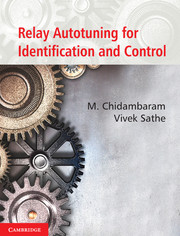Book contents
- Frontmatter
- Contents
- List of Figures
- List of Tables
- Acknowledgements
- Preface
- 1 Introduction
- 2 Improved Autotune Identification Methods
- 3 Cascade Controllers Tuning by Relay Autotune Method
- 4 Simultaneous Relay Autotuning of Cascade Controllers
- 5 A Simple Method of Tuning Cascade Controllers
- 6 Improved Saturation Relay Test for Systems with Large Dead Time
- 7 Identification of FOPTD Model using Single Symmetrical Relay Test
- 8 Autotuning of PID Controllers for Unstable FOPTD Systems
- 9 Autotuning of PID Controllers for Critically Damped SOPTD Systems
- 10 Estimation of SOPTD Transfer Function Model
- 11 Estimation of Five Parameters of Unstable SOPTD Model with a Zero
- 12 Identification of FOPTD Multivariable Systems
- 13 Identification of SOPTD Multivariable Systems
- 14 Tuning of Multivariable Controllers for Non-Minimum Phase Systems
- 15 Tuning of Multivariable Controllers by Genetic Algorithms
- 16 Summary and Conclusions
- Appendix A
- Appendix B
- Appendix C
- Nomenclature
- Problems
- Suggestive Reading
- References
- Index
Preface
Published online by Cambridge University Press: 05 June 2014
- Frontmatter
- Contents
- List of Figures
- List of Tables
- Acknowledgements
- Preface
- 1 Introduction
- 2 Improved Autotune Identification Methods
- 3 Cascade Controllers Tuning by Relay Autotune Method
- 4 Simultaneous Relay Autotuning of Cascade Controllers
- 5 A Simple Method of Tuning Cascade Controllers
- 6 Improved Saturation Relay Test for Systems with Large Dead Time
- 7 Identification of FOPTD Model using Single Symmetrical Relay Test
- 8 Autotuning of PID Controllers for Unstable FOPTD Systems
- 9 Autotuning of PID Controllers for Critically Damped SOPTD Systems
- 10 Estimation of SOPTD Transfer Function Model
- 11 Estimation of Five Parameters of Unstable SOPTD Model with a Zero
- 12 Identification of FOPTD Multivariable Systems
- 13 Identification of SOPTD Multivariable Systems
- 14 Tuning of Multivariable Controllers for Non-Minimum Phase Systems
- 15 Tuning of Multivariable Controllers by Genetic Algorithms
- 16 Summary and Conclusions
- Appendix A
- Appendix B
- Appendix C
- Nomenclature
- Problems
- Suggestive Reading
- References
- Index
Summary
To design proportional plus integral (PI)/PID controllers, the ultimate values of the controller gain (ku) and frequency of oscillation (ωu) should be known. The conventional Ziegler and Nichols continuous cycling method requires a large number of experiments to calculate these values. Åström and Hägglund (1984) suggested the use of ideal relay to generate closed loop oscillations. The ultimate gain and ultimate frequency can be found in a single-shot experiment. However, the method is still approximate because of the use of the principal harmonics approximation. Li et al. (1991) reported that for an open loop, stable first order plus time delay (FOPTD) system, an error of -18% to 27% is obtained in the calculation of ku. Yu (1999) suggested a saturation feedback test to get better results for the ultimate gain and frequency. However, Yu (1999) did not report any result for large values of delay-to-time constant ratio.
An SOPTD model can incorporate higher order process dynamics better than an FOPTD model. The controller designed on the basis of the SOPTD model gives a better closed loop response than the one designed on an FOPTD model. It is better to have an SOPTD model with equal time constants since only three parameters are to be identified. Li et al. (1991) showed that the conventional analysis of the relay autotune method for an SOPTD model with equal time constants gives -11% to 27% error in the calculation of ku.
- Type
- Chapter
- Information
- Relay Autotuning for Identification and Control , pp. xxiii - xxivPublisher: Cambridge University PressPrint publication year: 2014



